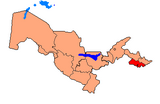Soʻx District
Soʻx District | |
|---|---|
| Soʻx tumani | |
 | |
| Country | Uzbekistan |
| Region | Fergana Region |
| Capital | Ravon |
| Established | 1942 |
| Area | |
| • Total | 220 km2 (80 sq mi) |
| Population | |
| • Total | 51,569 |
| Time zone | UTC+5 (UZT) |
Soʻx District (also spelled as Sokh, Uzbek: Soʻx tumani) is a (district) of the Fergana Region. It is an exclave of Uzbekistan, surrounded by Kyrgyzstan. Its capital is Ravon. Another village in the district is Limbur. It is noted that despite being a part of Uzbekistani territory and being surrounded by Kyrgyzstan, its population is mostly Tajik.[1]
Geography[]
The territory of Sokh is divided into two parts, separated by Kyrgyzstan:
- Northern Sokh (or Lower Sokh), including the town of Chon-Qora.
- Southern Sokh (or Upper Sokh), which is much more extensive than Northern Sokh. The area encompasses nineteen localities with an urban population of 65.9 percent and a rural population of 34.1 percent. It is 99 percent Tajik, 0.7 percent Kyrgyz and 0.3 percent Uzbek.
The exclave's name comes from the Sokh River, 124 km long, which crosses the territory and waters its fertile valley. The exclave is surrounded by the Kyrgyz province of Batken. Sokh's border is 135 km long, with nine border posts guarded by Kyrgyzstan.
Population[]
The population was 42,800 in 1993 (with some estimates as high as 70,000).
History[]
Together with Kokand, Sokh was one of the centres of the Basmachi uprising from 1918 to 1924. At that time Sokh was still directly connected with Uzbekistan.[2]
Sokh was created in 1955. Local legend holds that “the territory was lost by a Kyrgyz Communist Party official in a card game with his Uzbek counterpart.” Others say it made sense to assign the area to Uzbekistan because the roads running along the Sokh river connected to Uzbekistan to the north rather than going through the rugged Kyrgyz territory to the east and west of the area in question.
In 1999, Uzbekistan claimed that militants from the Islamic Movement of Uzbekistan (IMU) were using Sokh as their base to attack Uzbekistan and Kyrgyzstan. Earlier that year, Tashkent had been rocked by a series of car bombings attributed to the IMU. Uzbekistan began mining the borders around Sokh, angering the Kyrgyz who claim Uzbekistan placed mines on its territory.[3]
Economy[]
The economy of Sokh is mainly based on agriculture (potatoes and fruits). The fields are supplied by the river Sokh so that agriculture is only possible in the valley plain. The Sokh valley forms a river oasis in the surrounding, barren grassland. The seasonal migration of the male labour force to Russia is also important. The exclave contains twenty-eight schools, two colleges, three clinics, twelve dispensaries and ten village health centres.
References[]
- ^ "Convoluted borders are hampering Central Asian integration". The Economist. ISSN 0013-0613. Retrieved 2020-04-15.
- ^ "Ferghana Valley enclaves: a travel guide". Caravanistan. Retrieved 2020-04-15.
- ^ Putz, Catherine. "More Trouble on the Kyrgyz-Uzbek Border". thediplomat.com. Retrieved 2020-04-15.
See also[]
- Sokh River
- Shohimardon, an Uzbekistan exclave in Kyrgyzstan
- Sarvan, a Tajikistan exclave in Uzbekistan
- Vorukh, a Tajikistan exclave in Kyrgyzstan
- Batken Region enclaves and exclaves
- Districts of Uzbekistan
- Fergana Region
- Enclaves and exclaves
- Uzbekistan geography stubs

